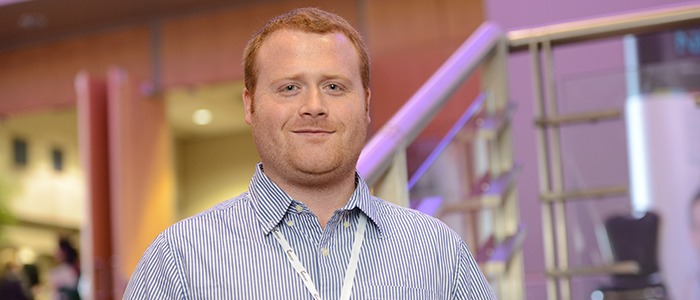Minding the gap junctions

As a child John Kelly, PhD, suffered from glue ear, a condition that causes fluid to build up in the middle ear, muting sound. He underwent two operations and a great deal of pain, but fortunately the condition was corrected. His childhood hearing problems spurred him to study the auditory system. Today he is doing postdoctoral work with Dale Laird, PhD, professor, Anatomy & Cell Biology, researching gap junction proteins.
Following completion of his BSc in Molecular Cell Biology at University College London (UCL), Kelly began his research in the area of auditory conditions, and completed his PhD in Auditory Cell Biology at the UCL Ear Institute.
His PhD research focused on the gap junction proteins such as connexin 26, a protein whose mutations are one of the most common causes of genetic hearing loss. He was fortunate to be funded by a four-year studentship awarded by Deafness Research U.K., and resulted in three first-author publications.
“Hearing loss is such a big problem with both the ‘iPod generation’ and the aging population. Because of this, the importance of hearing research will only increase,” Kelly said. He fell in love with research during his PhD and decided to pursue it as a career path. This led him to the Laird Lab in the Department of Anatomy and Cell Biology at Schulich Medicine & Dentistry, Western University.
Kelly has spent a productive two years as a postdoctoral trainee in Laird’s lab. Here, he is still working on connexins, but is now focusing on the mutations in connexin 30. Mutations of this protein can cause skin disease, hearing loss, or a combination of both. Kelly is looking at why the mutations in this one protein give such different phenotypes.
He is also investigating connexin 43, a protein whose mutations are linked to a rare disease called oculodentodigital dysplasia (ODDD). Laird’s lab is considered an authority on ODDD, as they are the only lab in the world that is studying the disease in detail. They are also the only lab in the world with human fibroblasts from patients who suffer from ODDD, as well as fibroblasts from unaffected family members of two of the patients. This gives them a serious advantage on the research. Kelly's work in Laird’s lab has resulted in three published papers with a few more coming down the pipe.
Kelly is also starting a side project, funded by a $10,000 grant from Action on Hearing Loss, a U.K.-based charity that funds international projects. With this project, Kelly will be studying the protein pannexin and the effect, if any, that pannexin-1 and pannexin-3 play in hearing loss. Not much is known about pannexin and its role in the body, so Kelly is hoping to shed some light on these proteins.
Ideally, Kelly would love to continue on with an academic career, and have his own lab staying with the connexin and pannexin biology.
“With 21 different types of connexins, the mutations of these proteins cause a lot of diseases, affecting pretty much every part of the body. However, there is no drug treatment or pharmacological treatments for many of the diseases caused by connexin mutations. I’d really like to focus on translational science, taking something that can improve people’s lives from the bench to the bedside,” Kelly said.
For now, it seems as though Kelly is well on his way to becoming an expert in the connexin gap junction field. This past year, he received first place in both the poster and oral presentation competitions in the postdoctoral category at the International Gap Junction Conference. With researchers like him minding the gap junction, it shouldn’t be too long until patients are benefitting from their discoveries.








